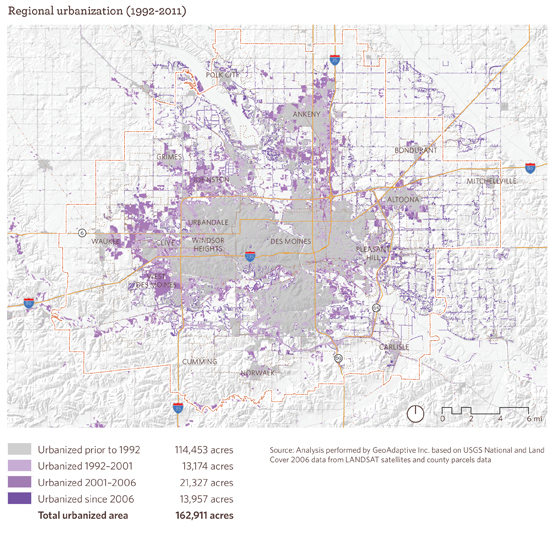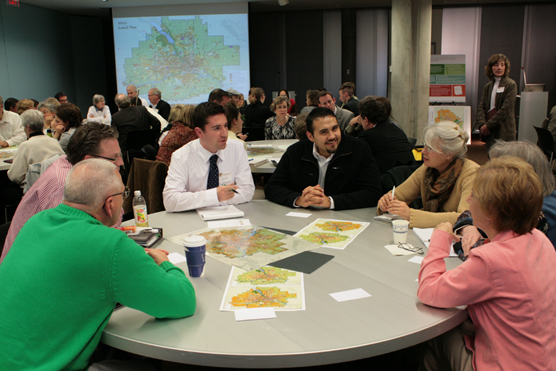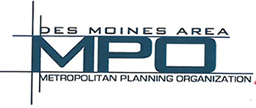Next week, discussion on the development of The Tomorrow Plan will continue at three public input sessions throughout the metro area. We want to know what you think Greater Des Moines should look like in the future, so join us to provide your perspective! The meetings are as follows:
- April 17, 2012 at 6:00 p.m. located at the Blank Park Zoo, 7401 SW 9th Street, Des Moines;
- April 18, 2012 at 11:30 a.m. located at the MPO Office, 420 Watson Powell Jr., Way, Des Moines; and,
- April 19, 2012 at 7:30 a.m. located at the Johnston Public Library, 6700 Merle Hay Road, Johnston.
As we move into this next phase of development for The Tomorrow Plan, we wanted to look back and provide a brief review of where we’ve been and also provide a sneak peek of some things to come.
Seven months ago, The Tomorrow Plan officially launched at an event that drew close to 350 participants. Since then, The Tomorrow Team has engaged in extensive public engagement through multiple public outreach series, several speaker series with prominent experts on sustainable development, increased web presence through social media, and numerous meetings with local stakeholders. The input gathered thus far has been invaluable in shaping the development of The Tomorrow Plan.
Initial work on The Tomorrow Plan resulted in the State of the Region report and complementary Sustainability Scan. The Sustainability Scan identifies best practices currently being utilized locally and throughout the country. The Scan also identifies opportunities and obstacles that currently exist. The State of the Region compiles various data sets from numerous sources to provide a comprehensive look at the current state of the metro area. Some highlights include:
- A well-educated workforce: Thirty-five percent of adults have a bachelor’s or advanced college degree.
- Strong employment growth: Over the past 20 years, annual employment growth has been 1.5 percent, well above the state’s average annual rate of 0.9 percent and the national rate of 0.8 percent.
- Economic activity is concentrated in professional services and financial activities; these industries have accounted for approximately half of all new jobs created over the past 20 years.
- Cars are the dominant mode of transportation, with 92 percent of person trips made using a personal vehicle.
- Our region boasts a recreational trail system with over 115 miles of trails.
- Centuries of land clearing and development have drastically reduced the region’s core natural habitat; ninety percent of natural habitat existing in the 1800s is now gone.

The State of the Region includes this regional urbanization map
On January 31, 2012, over a three-day period, The Tomorrow Team unveiled a “Business as Usual” scenario for the future of the metro region. The Business as Usual scenario was developed utilizing past development trends to predict what our region might look like in 2050. At the public meetings, the Business as Usual scenario helped participants visualize a potential future and to identify their priorities for the future development of the region. The Business as Usual scenario and feedback from the public meetings were utilized by The Tomorrow Team to further develop additional potential futures.

Public meeting participants discuss the “Business as Usual” scenario
What’s Next
Next week, The Tomorrow Team will host another series of public meetings to unveil Design My DSM, an online tool that will provide you an opportunity to share your priorities for the region. Your priorities will be compiled with those of other metro-area residents to develop the citizens’ design potential future scenario.
The public meetings will include a brief review of the Business as Usual scenario and a group game based on Design My DSM. This version of the game will give participants the opportunity to work together to develop a set of priorities for the future of region.
Please join us for one of the public meetings next week, and visit www.thetomorrowplan.com starting on April 17th to play Design My DSM!
 Luke Parris is an Associate Transportation Planner at the Des Moines Area Metropolitan Planning Organization and assists in the development of The Tomorrow Plan. He also oversees transportation funding and programming for the MPO and works on regional planning for the larger central Iowa area.
Luke Parris is an Associate Transportation Planner at the Des Moines Area Metropolitan Planning Organization and assists in the development of The Tomorrow Plan. He also oversees transportation funding and programming for the MPO and works on regional planning for the larger central Iowa area.



